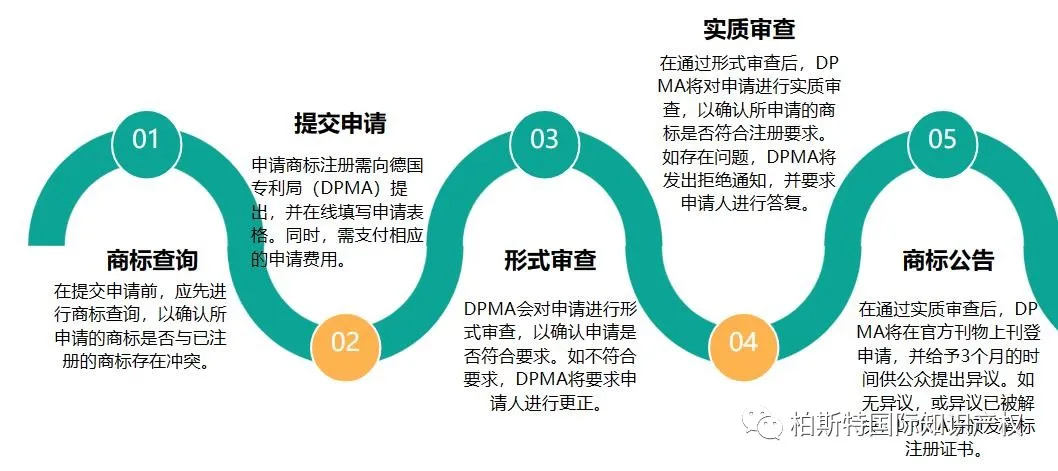- European

The current trademark regulations in Germany are mainly based on the Trademark Law, which was promulgated on October 25, 1994 and revised on October 19, 2013. The German Patent and Trademark Office is responsible for managing trademark affairs, and the official language is German. Trademark rights need to be obtained through registration. Trademark registration is not mandatory, but in order to protect the trademark or renew it, it must be registered in accordance with the law. German trademark registration adopts the principle of "application first", but for trademarks that already have a certain level of popularity, trademark rights can also be claimed based on "prior use".
At present, the German government adopts the Nice Classification 11th edition of product and service descriptions and accepts applications for multiple categories with one standard. The elements that can be registered as trademarks in Germany include: text, name, graphics, three-dimensional identification, color combination, sound, smell, etc.
1. Signs lacking significant features on goods or services;
2. A mark consisting solely of markings or indications that can be used in circulation to indicate the type, quality, quantity, purpose, value, geographical origin, production time, or other characteristics of goods or services;
3. A mark consisting only of marks or annotations commonly used in general language environments or business practices to indicate goods or services;
4. Signs that may cause confusion among the public, especially those indicating the type, quality, or geographical origin of goods or services;
5. Signs that violate public order or good customs;
6. Containing the national emblem, national flag, or other symbols of national sovereignty, or the emblem of a certain place, town, or local organization within the country
7. Signs containing official inspection or guarantee marks published in accordance with the law;
8. Emblems, flags, other marks, seals, and other symbols of international intergovernmental organizations that are not allowed to be registered as trademarks according to law;
9. Other signs that are prohibited from being registered as trademarks due to public interest needs.
For the symbols included in 1, 2, and 3 mentioned above. If distinctiveness is obtained through use, it can be registered as a trademark.
The German trademark is valid for 10 years after registration, starting from the date of application; Renewal can be processed within 6 months before the expiration date, with a grace period of 6 months and an additional recovery period of 6 months; The renewal period is 10 years.
The invalidation or revocation application after trademark registration can generally be filed in accordance with the following provisions of Chapter 3 of the German Trademark Law:
1. Article 50 of the Trademark Law: Violation of the "absolute grounds" provision of this Law;
2. Article 51 of the Trademark Law: Violation of the provision of "relative grounds" in this Law;
3. Article 49 of the Trademark Law: If a trademark has not been actually used in the country for five consecutive years after registration, anyone may apply for revocation,
Except for force majeure.
Trademark revocation/invalidation applications can be filed with the German Patent and Trademark Office, and under current examination conditions, it generally takes about one year.
Germany is a signatory to international intellectual property treaties such as the Singapore Treaty, the Paris Convention, the Nice Agreement, the WIPO Convention, and the Trademark Law Treaty. It is also a member of the Madrid Agreement, the Madrid Protocol, and the European Union.
1. Article 26 of the German Trademark Law also provides specific provisions on the common use of trademarks:
(1) When declaring or maintaining the right to use a registered trademark, the trademark should be used truthfully on the registered goods/services, except for force majeure;
(2) The use authorized by the registered trademark owner to others shall be deemed as actual use;
(3) If the actual use of the trademark is inconsistent with the registered trademark and the significant features of the registered trademark are not changed, it shall be deemed that the registered trademark has been actually used;
(4) The use of a registered trademark on a product or its packaging, even if the product is only used for export purposes, shall be deemed as actual use in that country;
(5) If there is a history of opposition to the registered trademark within 5 years after proving its use, the deadline should be adjusted to 5 years from the date of the opposition ruling.
2. When registering a trademark in Germany, there is no examination of "relative reasons", which means that the official will not actively reject the application based on the similarity between the trademark and the prior trademark. Therefore, the trademark is easy to pass the initial review and be announced. This requires the rights holder to continue to pay attention, conduct testing, and timely raise objections to protect their trademark rights even after the application is successfully registered.
3. In addition, when registering a trademark in Germany, a registration certificate will be issued first and then announced. If the trademark is objected to during the announcement period, even if the registration certificate has been obtained, it cannot take effect.
1. Single country registration;
2. EU trademark registration;
3. Madrid International Registration designates either the European Union or Germany.

Before submitting an application, a trademark search should be conducted to confirm whether the applied trademark conflicts with a registered trademark.
To apply for trademark registration, you need to submit it to the German Patent Office (DPMA) and fill out the application form online. At the same time, corresponding application fees need to be paid.
DPMA will conduct a formal review of the application to confirm whether it meets the requirements. If it does not meet the requirements, DPMA will request the applicant to make corrections.
After passing the formal examination, DPMA will conduct a substantive examination of the application to confirm whether the applied trademark meets the registration requirements. If there are any issues, DPMA will issue a rejection notice and request the applicant to respond.
After passing the substantive review, DPMA will publish the application in the official journal and give the public three months to raise objections. If there are no objections or the objections have been resolved, DPMA will issue a trademark registration certificate.
If the applicant does not reside in Germany, they must entrust a specialized agent in the country to handle it. The basic materials required for trademark application are:
1. Trademark design
2. Category and specific product items;
3. Name and address of the applicant;
4. If priority is declared, priority proof documents and corresponding German translations must be provided.




